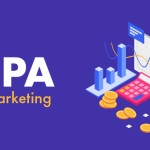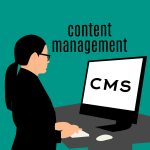Online presence is a vital aspect of branding in a digitalized world; this is why businesses now have dedicated websites. People can only buy your product or patronize your service if they have access to information about your business online.
Most business owners do not hire web developers; instead, they use content management systems (CMS) to build the desired website for their business.
In this article, I will talk about the meaning of CMS, its types, how it works, and how to decide which one to use for your business.
Table of Contents
What is Content Management System?
A content management system (CMS) is a software application that helps you to create and manage a website even if you do not have technical coding knowledge. Most CMS come with customizable designs, plugins and extensions, content editors, and other management tools that help to build your most desired website.
Over 2.14 billion people buy items online; about 8 out of 10 people prefer to go online to look up what they want before heading to their local store. Most of these people browse on websites that use a certain type of CMS to look up what they desire to buy.
As a business owner, working with CMS means that you can control what you will share on your website. Additionally, using CMS is more affordable than hiring web developers because you can easily schedule the contents you want to publish.
Most importantly, CMS works with any size of business, whether you are just starting up or you have a big name in your industry.
Types of Content Management Systems
There are different types of CMS, understanding their unique properties will help you select what is best for your business. The major types of content management systems are;
-
Web content management system (WCMS)
A WCMS is used exclusively for web content. It helps you manage the digital aspects of your business without knowing any programming language.
With WCMS, you can publish content automatically and customize your web pages. Examples of WCMS are Joomla, Drupal, Org, Volusion, etc.
-
Component content management system (CCMS)
The CCMS manages bits of information on your content. CCMS takes this information page by page and step by step.
Components of bits managed using CCMS include paragraphs, words, phrases, and photos. The CCMS will store these components for later reuse. Examples of CCMS are Sanity, MadCap Central, Hygraph, Storyblok, Paligo, etc.
-
Enterprise content management system (ECM)
Large organizations use the ECM to manage their documentation and ensure that vital information gets to their audience.
Using ECM gives each member of the organization access to a There is a central depository where they can complete their projects. Examples of ECM are DocuWare, DocSend, Laserfiche, FileCloud, Nuxeo Platform, DocStar, etc.
-
Document management system (DMS)
A document management system is used to organize and track digital documents in cloud storage. In this way, documents are edited and shared among users. Examples of DMS are Google Drive, eFileCabinet, M-Files, OnlyOffice, LogicalDOC, Dropbox Business, etc.
-
Digital asset management system (DAM)
The digital asset management system is a cloud-based solution for organizations and their customers. It consists of a central library where all people involved in the business process can access digital content like videos, audio, presentations, etc. Examples of DAM are Bynder, Scaleflex, MarcomCentral, Canto, Filecamp, Acquia DAM (Widen), 4ALLPORTAL, Wedia, etc.
Read Also: 6 Ways to Build Your Online Presence as an Entrepreneur
How Does a Content Management System Work?
The content management system work based on the integration of two major components. They are;
- The content management application (CMA)
- The content delivery application (CDA)
The CMA handle tasks that involve interacting with the CMS user interface. Using the CMA helps you to create and edit a post, add extensions, create the permalink structure, etc.
Therefore, the CMA is essentially the area on your CMS where you build your marketing content, copies, images, videos, etc. This area is popularly referred to as the CMS dashboard.
On the other hand, the CDA is the component that brings the content to the front of your audience. In simple terms, the CDA allows your audience or customers to see any new offer, promotions, discount or other important information concerning your business.
When you hire a website developer to design your business website, the developer will need to manually upload pages to your site. The CDA has made this easier by reducing the burden of uploading.
Additionally, the CDA stores the published content after displaying it to your audience. Hence, your audience can always click on the specific link to access the content anytime, anywhere.
Read Also: Free Tools for Building an ecommerce Website
How to Decide Which Content Management System to Use for Your Business
As a business owner or entrepreneur, several unique choices will affect the type of content management you use.
For instance, WordPress CMS is good for bloggers because of its robust content integration ability but it is not the best choice for someone who wants to sell products (like clothes, watches, etc.) online. The most popular and one of the best CMS choices for online merchandise or e-commerce is Shopify.

WordPress CMS dashboard
If choosing a CMS for your business is not easy, you may want to consider the following;
-
Cost
Although many CMS are free you will need to subscribe to paid plans for others. So, you might want to know whether or not your chosen CMS is free and if it is paid, you need to know about their subscription plan and cost.
As a start-up, it is better you use free CMS like Weebly, Bolt, Wix, WordPress, etc., this will save you additional expenses. If your business as expanded, you may need additional features which are not in free CMS. If this is the case, you can use paid CMS like HubSpot, Squarespace, Magnolia, etc.
-
Scalability
As a business owner, you probably want your brand to expand; this may mean an increase in the volume of customers. Customers increase mean an increase in the number of people that visit your web.
As your business grows, you don’t want to be changing from one CMS to the other. Besides, changing may cost more money and you will not want to start building your site from the beginning even though there are CMS templates you can use.
The solution is choosing a CMS you can scale or upgrade to the present number of customers. For this reason, using WordPress and Drupal will be to your advantage.
-
Design templates
CMSs come with design templates; however, you can efficiently handle some templates more than others. You should consider choosing the CMS with a template you can easily use.
Better still, you can choose CMS with numerous templates and select the one you can easily tweak. WordPress offers one of the largest number of templates for new and growing businesses.
-
Support
The next important thing to consider when choosing a CMS is the type of support that such CMS has for your business. For instance, a CMS that supports video publishing will not function optimally for businesses whose aim is to reach their customers using texts.
To know the type of support you want in a CMS, you should consider asking yourself; How do I intend to convert my audience? Do I intend to publish texts, images, or videos, or do I want a combination of all? What will be the function of my website? What technologies will be necessary for the optimal function of the CMS I intend to use? How easily can I create or edit content? If you can answer these questions, you are a few steps closer to selecting the best CMS for your business. As a rule of the thumb, WordPress is one of the CMSs that offers addition of video, image and text contents. But if WordPress seems technical for you to handle, you may consider Drupal, Joomla or TYPO3.
Beside these, you should consider the function, structure, and target audience of your business when choosing a CMS platform. Know that your target audience will influence how you want your content to be sent, and this will depend on the type of CMS you decide to use.
Read Also: How to Start a WordPress Development Business
Conclusion
Going through the hassles of hiring a web developer will cost you time and energy when you want to set up a website for your business.
Most CMS offer the best option for building a timely and responsive website, especially when you are just starting up and have no coding knowledge.
Don’t miss out on valuable content deliveredright into your inbox, subscribe to our newsletter to get notified about new ones.
About Author
- Olawale Moses Oyewole is a digital strategist who stays on top of current events and curate informative and engaging articles for his readers. He helps brand locate their target audience and enhance their online visibility.
Latest entries
 EntrepreneurFebruary 6, 2023A Comprehensive Guide to CPA Marketing in Nigeria
EntrepreneurFebruary 6, 2023A Comprehensive Guide to CPA Marketing in Nigeria EntrepreneurJanuary 22, 2023Content Management System: Types, How They Work and How to Decide for Your Business
EntrepreneurJanuary 22, 2023Content Management System: Types, How They Work and How to Decide for Your Business TechnologyJanuary 10, 2023Top 10 Budding Skills For Backend Developers in 2023
TechnologyJanuary 10, 2023Top 10 Budding Skills For Backend Developers in 2023 TechnologyDecember 31, 2022An Insightful Guide On The Functions of A Full Stack Developer in Nigeria
TechnologyDecember 31, 2022An Insightful Guide On The Functions of A Full Stack Developer in Nigeria

